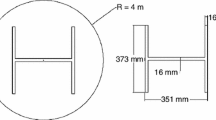Abstract
This paper evaluates the flexural behavior of laterally loaded piles using field data results from the pressure meter test (PMT) and standard penetration test (SPT). The analyses are performed using one of the most commonly available software, Lpile, in which the soil properties used are interpreted from SPT results. Lpile results are compared with the ones obtained from Foxta software which directly uses PMT soil parameters in its analysis. A database of 11 bored piles subjected to different values of lateral loads and imbedded in different soil conditions from 4 sites in Algeria is used for the piles lateral response evaluation. The pile bending moments and pile head deflections calculated using both software are compared. It was observed that Lpile consistently overestimates the pile bending moment, while the difference in pile deflection predicted from each software is small and results are quite comparable. To verify the analysis, a case study from France is used where measurements from actual field experiment carried out on a steel laterally loaded pile are used to compare the measured pile straining actions with the predicted ones. A good agreement is observed between the measured results and those induced from Foxta, while the results obtained from Lpile are slightly overestimated. This finding matches with the evaluation of the pile lateral response performed in this study. A detailed comparison between the different methodologies used in each software and the reason behind receiving different results is explicitly given in this research.







Similar content being viewed by others
References
Bowles JE (1997) Foundation analysis and design, 5th edn. McGraw-Hill, New York, p 502
LPile, Version 2019. Program for the analysis of deep foundations under lateral loading, Ensoft, Inc, Texas. http://www.ensoftinc.com
Foxta, Version 3. Program for the design of shallow, deep, and raft foundations, pile groups, and piled-raft foundations, by Terrasol, France. https://www.terrasol.fr/
Bustamante M, Gianeselli L (2006) Règles de calcul de la portance des pieux aux ELU. Méthode pressiométrique. In: proceedings International Symposium on ULS of Geotechnical Structures, Marne-la-Vallée, Droniuc, Magnan et Mestat (eds), Editions du LCPC, Paris
Basudhar PK, Obaidur R, Kalyancharan Y (2018) Flexural analysis of laterally loaded piles: prediction and performance. J Geotech Geol Eng 36:3893–3902
Menard L (1969) Comportementd’une foundation profondesoumise a des efforts de renversement. Reglesd’utilisation des techniques pressiometriques, notice Speciale No. 2, Document Interne D/62/69, Centre d’Etudes Geotechniques, Paris, Sols Soils No. 3, pp 9–27
Menard L (1975) The Menard pressuremeter: interpretation and application of the pressuremeter test results to foundations design. Techniques Louis Menard, Paris
Fascicule 62-Titre V (1993) Regles techniques de conception et de calcul des fondations des ouvrages de genie civil. Ministere de l’equipement, du logement, et des transports, Publications Eyrolles, Paris, pp 182
Frank R (2009) Design of foundations in France with the use of Menard pressuremeter tests (MPM). Soil Mech Found Eng 46(6):219–231
Baguelin F, Jezequel JF, Shileds DH (1978) The pressuremeter and foundation engineering. Trans Tech Publications, Clausthal-Zellerfeld
Gambin M, Frank R (2009) Direct design rules for piles using Ménard pressuremeter test. In: proceeding of international foundation congress and equipment Expo’09 (IFCEE’09), Orlando, Florida, ASCE, Geotechnical Special Publication No. 186, pp 111–118
Matlock H (1970) Correlations for design of laterally loaded piles in soft clay. Offshore technology in civil engineering hall of fame papers from the early years, pp 77–94
Reese L, Cox W, Koop F (1974) Analysis of laterally loaded piles in sand. In: proceedings, 6th annual offshore technology conference. Houston: Offshore technology conference, pp 473–485
Reese LC, Welch RC (1975) Lateral loading of deep foundations in stiff clay. J Geotech Eng Div 101(GT7):633–649
Reese C, Van Impe W (2001) Single piles and pile groups under lateral loading. Taylor and Francis Group, London
Uchida A, Hatakanda M (1996) Empirical correlation between penetration resistance and effective friction angle of sandy soil. Soils Found 36(4):1–9
Foster BH (2016) Deformation analysis methods for drilled shaft foundations subjected to lateral and overturning moment loads. Master of Science, College of Engineering, University of Utah, USA
Bigot G, Bourges F, Frank R (1982) Etude experimentale d’un pieu soumis aux poussees laterales du sol. Rev Fr Geotech 18:29–47
Author information
Authors and Affiliations
Corresponding author
Ethics declarations
Conflict of interest
The authors declare that they have no conflict of interest.
Rights and permissions
About this article
Cite this article
Mostafa, H.H. Lateral response evaluation of single piles based on pressuremeter test results (using Foxta) versus standard penetration test results (using Lpile). Innov. Infrastruct. Solut. 7, 271 (2022). https://doi.org/10.1007/s41062-022-00870-4
Received:
Accepted:
Published:
DOI: https://doi.org/10.1007/s41062-022-00870-4




